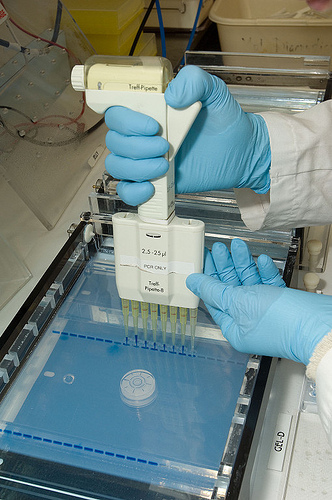Hi, I’m Dr. Janet Whaley, an aquatic veterinarian and avid angler. I guess you could say fish are my passion! I work every day to ensure the continued health of our nation’s fish, so that in my spare time, I can be out on the water with my fishing pole and a camera.
Invasive species can spread unintentionally on land and in the water. This could damage our waters and our forests – and leave us with unhealthy or fewer fish to catch. I don’t know about you, but I want to be sure I can bring my family fishing for years to come. So I take proper steps to help keep invasive species in check. The basic steps all anglers (and boaters, too) need to keep in mind include: Read more »

Painting by Taina Litwak of a new species of tiny parasitic wasp in the genus Perischus. Done in 2011 for Dr. Matt Buffington. The painting starts with a pencil drawing done through the microscope of a dead pinned specimen. Details for this painting were included which only are visible in scanning electron microphotographs, as the species is so very small. The painting itself is done digitally in Adobe Photoshop. The species was first collected in South America in 2010 and is involved with parasitizing a species complex of flies which lay eggs in cucurbit plants (melon, cucumber and squash family).
I am a scientific illustrator on staff with the Systematic Entomology Lab, in the Plant Sciences Institute, ARS, located in the Smithsonian Institution’s Museum of Natural History. Last week, I had the pleasure of meeting Secretary Vilsack, who was interested in several of my paintings of newly described species of insects that I entered in the U.S. Department of Agriculture’s (USDA) 2012 Employee Art Exhibit. As I answered his questions, it occurred to me that people may not associate USDA with artistry or illustration and that my job as “Scientific Illustrator” may in fact seem unusual to many. Read more »

An APHIS employee at the Center for Plant Health Science and Technology Otis Lab prepared an agarose gel for electrophoresis of DNA. The Otis Lab’s mission is to identify, develop, and transfer technology for the survey, exclusion, and control of plant pests and diseases.
It’s at that first alarm, when an invasive species is discovered within U.S. borders, that scientists at USDA APHIS’ Center for Plant Health Science and Technology (CPHST) power up to solve a biological puzzle and protect American resources. Read more »
The mission of USDA-APHIS Wildlife Services is to provide expertise to resolve wildlife conflicts and allow people and wildlife to coexist. During my recent trip to South Florida I toured Homestead Airbase and learned firsthand about an extremely valuable service provided by APHIS-WS that most folks are not familiar with.
The APHIS-WS team provides recommendations on habitat conditions and wildlife management techniques that help reduce wildlife hazards to aviation. As a result, birdstrikes at Homestead have been reduced by over 90%. This valuable service continues to protect the aviators and 26 F-16 Fighter jets housed there. Read more »

Giant African snails can reach up to 8 inches in length and nearly 5 inches in diameter—about the size of an average adult fist—and can live up to nine years. In a typical year, mated adults lay about 1,200 eggs.
For the past several months, USDA’s Animal Plant Health Inspection Service (APHIS) and its partners at the Florida Department of Agriculture and Consumer Services (FDACS) have been fighting to stop the spread of the giant African snail—a nasty invasive pest that threatens Florida’s agricultural sector. Read more »

USDA Deputy Under Secretary for Marketing and Regulatory Programs, along with Maryland Agriculture Secretary Buddy Hance, discuss the damage that can be done by emerald ash borer and raise a purple trap for the 2012 EAB survey season.
The Patuxent Wetlands Park is a lovely setting in Anne Arundel County, Maryland where vibrant tidal wetlands give way to the Patuxent River. It is a place where the community enjoys fishing, boating and nature. It is also the site of one of the 500 purple, prism-shaped traps hanging high in Maryland ash trees this spring and summer. The purple traps help State and Federal officials to uncover signs of the invasive, tree-killing emerald ash borer (EAB) beetle. Read more »




